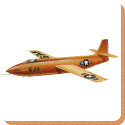 Bell X-1 — The Bell X-1, originally designated XS-1, was a joint NACA (National Advisory Committee for Aeronautics) – U.S. Army / US Air Force supersonic research project built by Bell Aircraft. Conceived in 1944 and designed and built over 1945, it eventually reached nearly 1,000 mph (1,609 km/h) in 1948. A derivative of this same design, the Bell X-1A, having greater fuel capacity and thus longer engine-burn time, exceeded 1,600 mph (2,574 km/h) in 1954. It was the first aircraft to exceed the speed of sound in controlled, level flight, and was the first of the so-called X-planes, an American series of experimental aircraft designated for testing of new technologies and usually kept highly secret.
Bell X-1 — The Bell X-1, originally designated XS-1, was a joint NACA (National Advisory Committee for Aeronautics) – U.S. Army / US Air Force supersonic research project built by Bell Aircraft. Conceived in 1944 and designed and built over 1945, it eventually reached nearly 1,000 mph (1,609 km/h) in 1948. A derivative of this same design, the Bell X-1A, having greater fuel capacity and thus longer engine-burn time, exceeded 1,600 mph (2,574 km/h) in 1954. It was the first aircraft to exceed the speed of sound in controlled, level flight, and was the first of the so-called X-planes, an American series of experimental aircraft designated for testing of new technologies and usually kept highly secret.
Design & Development
On 16 March 1945, the United States Army Air Forces’ Flight Test Division and the National Advisory Committee for Aeronautics (NACA) (now NASA – National Aeronautics and Space Administration) contracted Bell Aircraft to build three XS-1 (for “Experimental, Supersonic”, later X-1) aircraft to obtain flight data on conditions in the transonic speed range.
The X-1 was in principle a “bullet with wings”, its shape closely resembled the Browning. 50-caliber (12.7 mm) machine gun bullet that was known to be stable in supersonic flight. The pattern shape was followed to the point of seating the pilot behind a sloped, framed window inside a confined cockpit in the nose, with no ejection seat. After the aircraft ran into compressibility problems in 1947, it was modified to feature a variable-incidence tailplane. An all-moving tail was developed by the British for the Miles M.52, and first saw actual transonic flight on the Bell X-1 that allowed it to pass through the sound barrier safely.
The rocket propulsion system was a four-chamber engine built by Reaction Motors, Inc., one of the first companies to build liquid-propellant rocket engines in America. It burned ethyl alcohol diluted with water and liquid oxygen. The thrust could be changed in 1,500 lbf (6,700 N) increments by firing one or more of the chambers. The fuel and oxygen tanks for the first two X-1 engines were pressurized with nitrogen and the rest with steam-driven turbopumps. The all-important fuel turbopumps, necessary to raise the chamber pressure and thrust, while lightening the engine, were built by Robert Goddard who was under Navy contract to provide jet-assisted takeoff rockets.
Operational History
Bell Aircraft Chief Test Pilot, Jack Woolams became the first to fly the XS-1, in a glide flight over Pinecastle Army Airfield, in Florida, on 25 January 1946. Woolams would complete nine additional glide flights over Pinecastle before March 1946, when the #1 aircraft was returned to Bell for modifications in anticipation of the powered flight tests, planned for Muroc Army Air Field (now Edwards Air Force Base) in California. Following Woolams’ death on 30 August 1946, Chalmers “Slick” Goodlin was the primary Bell Aircraft test pilot of X-1-1 (serial 46-062). He made 26 successful flights in both of the X-1 aircraft from September 1946 until June 1947.
The Army Air Force was unhappy with the cautious pace of flight envelope expansion and Bell Aircraft’s flight test contract for aircraft #46-062 was terminated and was taken over by the Army Air Force Flight Test Division on 24 June after months of negotiation. Goodlin had demanded a US$150,000 bonus for breaking the sound barrier. Flight tests of the X-1-2 (serial 46-063) would be conducted by NACA to provide design data for later production high-performance aircraft.
 Kids Portal For Parents India Kids Network
Kids Portal For Parents India Kids Network
